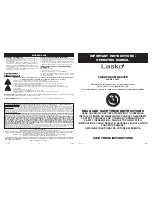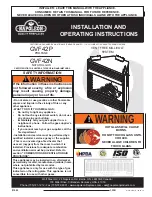
Functioning of the appliance
16
Instruction Manual BFC
2
gis
Table 2.2
shows the trip point per appliance.
n
Remark
The trip point of the pressure switch is not adjustable.
2.4.5
Ionisation rod
To ensure that no gas will flow when there is no combustion, an ionisation rod
has been fitted. The ThermoControl uses this rod for flame detection, by means
of ionisation detection. The ThermoControl cuts in, the instant it detects that
there is a gas flow but no flame.
2.5
Safety of the instal-
lation
In addition to the appliance’s standard safety monitoring, the appliance must
also be protected by an expansion vessel, pressure overflow valve, non-return
valve and a T&P valve.
Use of an expansion vessel, a pressure relief valve and/or a pressure reducing
valve depends on the type of installation: unvented or vented.
2.5.1
Unvented installation
With an unvented installation, a pressure relief valve and expansion vessel
prevent excessive pressure in the tank. This prevents damage being caused to
the enamelled coating (in the appliance) or to the tank. A non-return valve
prevents excessive pressure in the water supply system. This valve also
prevents water from flowing backwards from the tank into the cold water supply
system. The pressure reducing valve protects the installation against an
excessively high water supply pressure (> 8 bar). These components are fitted
to the cold water pipe. See paragraph
’3.6.1 Cold water side’
.
2.5.2
Vented installation
With a vented installation, excess pressure is taken up by the open water
reservoir. The level of the water reservoir determines the maximum working
pressure in the tank, which may not exceed 8 bar. The installation must also be
fitted with an overflow from the hot water pipe, which discharges into the water
reservoir. See paragraph
’3.6.2 Hot water side’
.
2.5.3
T&P valve
A T&P valve is only mandatory in an ‘unvented’ installation. However,
A.O. Smith also recommends the use of a T&P valve in ‘vented’ installations.
A T&P valve monitors the pressure in the tank, and the water temperature at the
top of the tank. If the pressure in the tank becomes excessive (>10 bar) or the
water temperature is too high (>97°C), the valve will open. The hot water will
immediately flow out of the tank. Because the appliance is under water supply
pressure, cold water will automatically flow into the tank. The valve remains
open until the unsafe situation has been averted. A connecting point for a T&P
valve is standard on the appliance. See paragraph
’3.6.2 Hot water side’
.
Table 2.2
Pressure switch trip points
Applianc
e
Pressure differential
[Pa]
Closing
Opening
BFC 28
> 635
< 605
BFC 30
> 855
< 825
BFC 50
> 885
< 855
BFC 60
> 1085
< 1055
Содержание 28 30 50 60
Страница 2: ...your installer www aosmithinternational com...
Страница 4: ...4 Instruction Manual BFC...
Страница 12: ...Introduction 12 Instruction Manual BFC 1 gis...
Страница 38: ...Installation 38 Instruction Manual BFC 3 is...
Страница 42: ...Filling and draining 42 Instruction Manual BFC 4 gis...
Страница 48: ...Status of the appliance 48 Instruction Manual BFC 6 gis...
Страница 64: ...Main menu 64 Instruction Manual BFC 8 gis...
Страница 68: ...Service program 68 Instruction Manual BFC 9 is...
Страница 84: ...Maintenance frequency 84 Instruction Manual BFC 11 gs...
Страница 94: ...Release R 1 3 UK 94...
















































